
Craft Distilling is Alive & Thriving in Vacationland
From Brewer to Biddeford, York to Gouldsboro, and Freeport to Union, Maine you can traverse our beautifully scenic state sampling some of the finest hand crafted, small batch spirits anywhere in the world. Now, along with Maine lighthouses and lobster shacks, the Maine Distilling Industry is chockablock full of adventure and reward.
Like many of our amazing restaurants where you’ll find a bevy of locally raised, grown, sourced – even foraged ingredients on their menus, you’ll find the same attention to both detail and the use of local agricultural products in the craft spirits made by members of Maine’s Distillery Guild.
Maine Craft Distilling used over 300,000 pounds of Maine-grown malted barley, and uses over 20,000 pounds of Maine blueberries annually in its blueberry Blueshine, and apples from Doles Orchard in Limington to make their Whipple Tree Apple Brandy.
Liquid Riot Bottling uses hundred of pounds of Maine grains in its whiskeys each year, including Maine-grown rye and buckwheat, and even some homegrown sweet Maine corn in their bourbon.
Cold River Vodka sourced and distilled over 1.4 million pounds of Maine potatoes for their vodka and gin.
Split Rock Distilling in Newcastle make a horseradish vodka using horseradish grown on Snakeroot Organic Farm in Pittsfield. Their blueberry vodka is made with wild, lowbush organic blueberries from Elderflower Farm in Lincolnville.
Sweetgrass Farm Winery & Distillery goes through 70,000 pounds of Maine-grown fruit and grains each year including apples for their cider and apple brandy from Hope Orchards, blueberries for their award-winning Back River Gin from Blueberry Valley Farm in North Union, and over 3,500 pounds of cranberries for their cranberry gin from growers in Washington County.
Many of the herbs and botanicals used in Tree Spirits award-winning absinthe such as — anise, fennel, wormwood, petite wormwood, hyssop and lemon balm — are locally sourced. Bartlett Spirits of Maine uses local apples, pears, berries and other fruit that make their way through crushing, fermenting and distilling grown in Maine.
Nothing but 100% pure Maine maple syrup is used in Chadwick Craft Spirits.
Some distilleries use Maine-grown, Maine-made white oak barrels to age their spirits to capture the best possible flavor of Maine. All while using some of the cleanest, best tasting water on the planet. Consider visiting some or all of us on your next trip to Maine. We’d love to see you.
[ezcol_1half]BARTLETT SPIRITS OF MAINE
175 Chicken Mill Pond Rd
Gouldsboro, ME
(207) 546-2408
www.bartlettwinery.com
CHADWICK’S MAPLE CRAFT SPIRITS
29 Chadwick Lane
Pittston, ME 04345
(207) 592-9080
www.chadwickscraftspirits.com
HARDSHORE DISTILLING COMPANY
53 Washington Avenue
Portland, ME 04101
(207) 536-0592
www.hardshoredistilling.com
LIQUID RIOT BOTTLING COMPANY
250 Commercial St.
Portland ME 04101
(207) 221-8889
www.liquidriot.com
MAINE CRAFT DISTILLING
123 Washington Ave.
Portland, Maine
(207) 536-1043
www.mainecraftdistilling.com
MAINE DISTILLERIES, LLC | COLD RIVER
437 US Route One
Freeport, ME 04032
(207) 865-4828
www.coldrivervodka.com
MOSSY LEDGE SPIRITS
1097 Lakins Rd
Etna, Maine
(207) 269-2244
www.mossyledgespirits.com
NEW ENGLAND DISTILLING
26 Evergreen Drive
Portland, ME 041013
(207) 878-9759
www.newenglanddistilling.com
NORTHERN MAINE DISTILLING CO.
55 Baker Boulevard
Brewer, ME 04412
www.twenty2vodka.com
ROUND TURN DISTILLING
32 Main Street|
Building 13W, Suite 103
Biddeford, ME
(207) 370-9446
www.roundturndistilling.com
SEBAGO LAKE DISTILLERY
463 Water Street
Gardiner, ME 04345
(207) 808-0379
www.sebagolakedistillery.com
SPLIT ROCK DISTILLING
16 Osprey Pt, Newcastle, ME 04553
(207) 563-2669
www.splitrockdistilling.com
STONE FORT DISTILLERY
26 Pearl Street Suite 204
Biddeford, Maine 04005
(207) 590-3528
www.stonefortspirits.com
STROUDWATER DISTILLERY
4 Thompsons Point
Portland, ME 04102
(207) 536-7811
www.stroudwaterdistillery.com
SWEETGRASS WINERY & DISTILLERY
2 Locations:
347 Carroll Road
Union, Maine 04862
(207) 785-3024
324 Fore Street
Portland, ME 04101
(207) 761-8446
www.sweetgrasswinery.com
TREE SPIRITS OF MAINE
152 Fairfield Street
Oakland, ME 04963
(207) 861-2723
www.treespiritsofmaine.com
WIGGLY BRIDGE DISTILLERY BARN
441 US-1
York, ME 03909
(207) 363-9322
www.wigglybridgedistillery.com

Using Hops in Your Home Brew
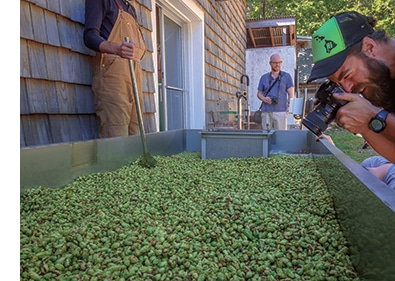 Hops (humulus lupus) those papery, puffy cones of green, go into almost every conceivable beer in some way, shape, or form and if you are a homebrewer or simply a lover of good ales and lagers, you know how sensational the appetite for hop-forward beers has been in recent years.
Hops (humulus lupus) those papery, puffy cones of green, go into almost every conceivable beer in some way, shape, or form and if you are a homebrewer or simply a lover of good ales and lagers, you know how sensational the appetite for hop-forward beers has been in recent years.
Cultivated over two millennia for medicinal use prior to ever finding their way into a brewery, hops are now commanding greater demand than ever in brewing. Hop cones, pellets, cryogenically derived powders, and extracts can be sourced both locally and from away.
Hops were not the first herbal supplement to beer. In fact, gruit brewing (or beer brewing without hops) was the first true brew in Medieval times. The Catholic Church even saw a profitable advantage to enacting a gruit tax as a major force of revenue during these times. Use of hops as an agent of flavor in the beer excluded the brewers from such a tax and thus the resourcefulness (and hatred of undue taxation) slowly turned the tide to favor hop additions. It was soon found that hops possessed a preservative nature to beverages. And, while generally more bitter than the gruit, techniques to limit bitterness began to arise with experimentation. In 1516, Germany even put forth a law known as reinheitsgebot, or a purity law, that is still in force today. That is – beer must only be made using hops, water, yeast, and malt. No other ingredients were allowed in a German beer. Inherent in this limitation came the vast array of permutations regarding just how to put hops into your brew.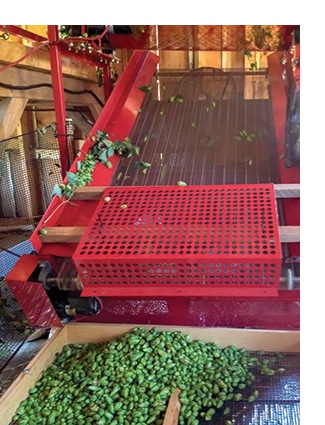
Hops in Maine have started seeing a sizeable uptick in production because of the demand. I caught up with Mike Barker owner and farmer of the Alna Hopyard in Alna, Maine recently during his delivery day of almost 200 pounds of wet (meaning fresh and undried) Cascade hops to Oxbow Brewery nearby. Alna Hopyard is a modest two acres of cultivated farmland, but it’s clear that the hopyard has made an impact on the locavore movement in both product and demand.
“Hops were produced here over a century ago, fell off, and then came back,” said Barker. “Brewing is a complicated process and getting the right characterization of hops is important.” One of the important aspects of brewing with hops is that the geographic area in which they’re grown. Location can impact the aromas, bittering capacity, and other elements of their use in beer. For instance, the hop named Fuggles (commonly found in British brewing that seeks earthy, spicier notes) when grown in Alna, evokes a kiwi fruit nose uncommon to the strain. Maine’s soil and environment didn’t get the memo that this wasn’t right, so the hops they use locally sometimes take some recalibration of brewing recipes.
According to Barker, the biggest strain on brewing with hops is capacity and supply-chain logistics. Some major IPAs brewed locally and year-round take serious hop doses to complete. For instance, the late-stage hop additions in some of Freeport’s Maine Beer Company’s hop-forward offerings can be hundreds of pounds per brew. The demand for consistent supply outstrips the available local market, and hops can take a few years or better to truly mature. “There are, by my last count, only 27 acres of land in Maine dedicated to hop production and some varieties of hops yield only 700-800 pounds of hops per acre,” noted Barker. It doesn’t take long for the math to show that these hops, harvested in the fall, are quickly scooped up by the market and organizing a regular supply-chain isn’t yet feasible. However, new hop yards are coming into the foreground across the state as people’s insatiable desire for floral, citrusy, or bitter beers persists. I would surmise that over time, Mainers will take back to the fields as we once did, but instead of potatoes or lumber, flowering plants become the hot commodity in the state.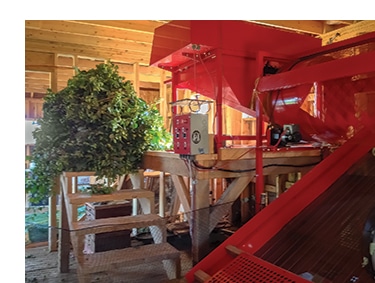
Now, let’s talk about how to best coax hops’ better natures into your homebrew or at least better understand what is in your glass.
First, I recognize that not every homebrewer is a “hop head.” You may not all seek out the tart, citrusy notes in the nose, or the piney sharp element on the tongue, or even that bitter backbone in the throat. Some of my closest friends prefer rich, malt-forward ales and lagers without the bitter or citrusy qualities. Yet, even here, hops play an important role in preserving the beers you love best. The trick lies in two parts: understanding the strength and nature of the ingredient and timing.
Each varietal of hop has its own unique properties. The cones that we trim from their bines (not vines) contain acids and oils of differing amounts. Most commonly, brewers refer to the Alpha Acid (AA) of a hop, which is the general bittering agent. When we put hops into a beer during the boil phase of brewing, the heat extracts these acids and infuses the liquid with it. However, the longer the hops stay in a rolling boil, the more the boil drives away some of the oils and essential elements that give hops their aroma. We generally consider early additions of hops to be those that give the beer bitterness. Mid-stage additions can be said to grant more flavor to the beer, and late stage (near the end of the boil) almost universally gives the beer the nose and aromatics many of us love in something like an IPA.
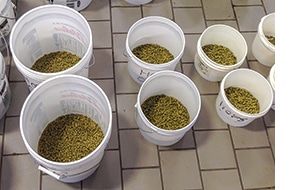 If you’re interested in learning more about the use of these amazing flowers in your beers, or to simply add to your own education, I’d recommend “For the Love of Hops: The Practical Guide to Aroma, Bitterness, and the Culture of Hops” by Stan Hieronymus, or simply “How to Brew” by John Palmer. And, of course, I would always recommend dropping by your local homebrewing supply store for more personal advice.
If you’re interested in learning more about the use of these amazing flowers in your beers, or to simply add to your own education, I’d recommend “For the Love of Hops: The Practical Guide to Aroma, Bitterness, and the Culture of Hops” by Stan Hieronymus, or simply “How to Brew” by John Palmer. And, of course, I would always recommend dropping by your local homebrewing supply store for more personal advice.
— Text: Matthew Brown. Matthew is a Certified Beer Server, a member of the American Homebrewers Association, and recently studied brewing in Belgium. He lives and works in Portland.
— Photos: Courtesy of Alna Hopyard.
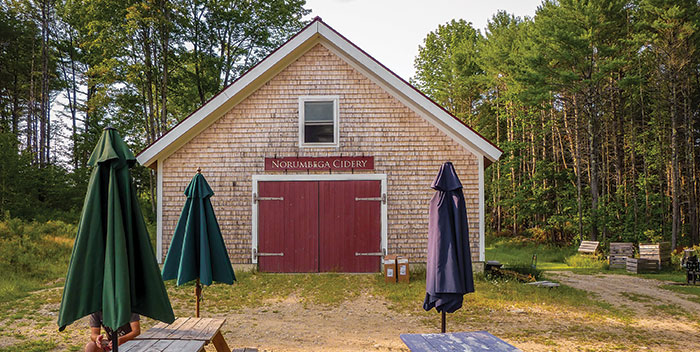
Core Values: Norumbega Cidery
It’s hard to think that Maine’s prolific craft beer industry is only a few decades old. The mighty cider, however, has been around for more than a few centuries, inspiring founders like John Adams, who allegedly consumed a tankard of hard cider each day. Hard cider was the first juicy “New England Style” beverage long before the hazy IPA swept the region by tempest.

Noah Fralich, Norumbega’s owner and cider maker
Norumbega Cidery, nestled in the rolling farmlands of New Gloucester, is keeping the tradition alive. Noah Fralich, Norumbega’s owner and cider maker, said, “It was the original colonial drink. People grew apples for livestock feed and then, for pies and cider.” Even homestead laws and land ownership sometimes correlated with orchard acreage at that time. It took Prohibition and a few intense winters in the early 20th century to hurt that iconic tradition. “People tore up their orchards, and many varieties of apples are gone now,” Fralich said. Lucky for us, Maine has since championed the growth of its craft culture, not its demise.
Fralich grew up in New Gloucester, and Norumbega is located on his family land. “It’s hard to know where the bug came from, but we planted some trees and had some blending parties,” he said. “It’s a family endeavor and we all dove right into it.” Fralich undertook an apprenticeship through Maine Organic Farmers and Gardeners Association (MOFGA) and attended some cider-making classes taught by Peter Mitchell, a renowned cider expert. Founded in 2013, Norumbega has remained a grassroots business, and yet, has been expanding its distribution range throughout Maine. Originally bottled in 22 oz. bottles, Norumbega Cider has since transitioned to cans and kegs, which has been more lucrative. As of now, Ricker Hill Orchards, which also makes local hard cider, supplies Fralich with pressed juice to keep up with the demand.
 Unlike many ciders, Norumbega ferments the sugars completely in order to achieve a crisp, clean, and dry flavor. “I’m inclined to think that palates are drying out,” said Fralich. “People are looking for things that are more refreshing, not as sweet.” The four core brands are: the Original, the Honey (dry with a gentle softness from Maine honey), the Berry (dry with a slightly tart finish due to the ghost of the mixed Maine berries), and the Spice (pleasantly balanced with fall spices). Small batches of specialty ciders are available at the cidery such as a ginger cider, an orange cider, and a bourbon barrel-aged cider, which is set to release in November.
Unlike many ciders, Norumbega ferments the sugars completely in order to achieve a crisp, clean, and dry flavor. “I’m inclined to think that palates are drying out,” said Fralich. “People are looking for things that are more refreshing, not as sweet.” The four core brands are: the Original, the Honey (dry with a gentle softness from Maine honey), the Berry (dry with a slightly tart finish due to the ghost of the mixed Maine berries), and the Spice (pleasantly balanced with fall spices). Small batches of specialty ciders are available at the cidery such as a ginger cider, an orange cider, and a bourbon barrel-aged cider, which is set to release in November.
As of now, the cidery is not open daily; however, it hosts monthly events from May to November. “Each month we have a food truck and live music,” said Fralich. “We throw the doors open, have a little bar, and people love it. It’s always pretty chill.” Norumbega also has tastings at the Brunswick Farmers Market every Saturday.
Though it is not as prolific as the Maine beer industry, the local cider scene is strong and growing. “I don’t think the interest is going to wane anytime soon, especially with cider being gluten free,” said Fralich. “But, cider is still not in the average person’s vocabulary when shopping, so a lot more growing can be done.”
Some of the earliest colonial maps of New England and Maine refer to this overall region as Norumbega, a mythical city of riches. The term has since become associated with tradition, regional pride, and a hopeful eye towards the future. And, that’s Norumbega Cidery at its core.
— Text & Photos: John Breerwood. John currently works as an Ed Tech at Lewiston High School. He has worked as a brewer and cellar man for Abita Brewing Company and Shipyard Brewing Company. His first novel is planned to be independently published in early 2019.

The Humble Brown Ale is Poised for a Mighty Comeback
While IPAs inspire wrap-around lines outside of breweries and sour ales bring beer lovers to Maine in droves, the brown ale has become a forgotten beer style. I mean, even the word “brown” inspires as much excitement as a pair of chino pants.
I bet you’re so meh towards brown ales that you even considered not reading this post when you discovered it was focused solely on browns. But it’s time to rethink your relationship with the modest brown ale.
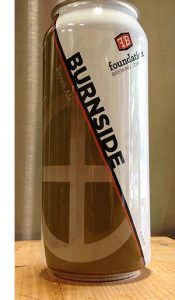
Foundation Brewing’s Burnside has a mocha hue and hints of nutmeg. Photo : Foundation Brewing.
Over the past few years, Maine brewers have begun releasing delectable brown ales that highlight the vast spectrum of flavors found inside this malt-forward style of beer, causing me to reconsider my own blasé stance on brown ales. So, as the cold air of fall and winter approaches, let’s give props to the oft-overlooked brown ale.
Taking a deep dive into the world of browns, you find it’s not an easy style to define. The brown ale is wedged somewhere between amber ales and porters. They are generally, well, brown in appearance, ranging from a golden hazel to deep walnut. Getting the bulk of their character from roasted malts, brown ales exude a number of different flavors: toasted cereal, sweet raisin, roasted coffee, and milk chocolate. Unlike porters or stouts, brown ales generally have a crisp ale finish from the use of American or English ale yeast.
Maine brewers are such a talented lot that when they start making a style, I take notice, even if it isn’t something that typically makes my palate tingle with anticipation.
The first Maine-brewed brown ale that caught my attention was the Burnside Brown from FOUNDATION BREWING.
Poured from a can, Burnside has an opaque mocha hue. Putting my nose right into the glass, I pick up nutty notes with hints of nutmeg. A swig of Burnside releases flavors of freshly roasted coffee beans, subtle molasses, and a delicate undercurrent of cocoa. As the beer warms up, it releases bigger milk chocolate notes on the palate. Like any brown ale worth its weight in malt, Burnside has a beautiful finish of brown sugar and crisp ale yeast. Crushing a few Burnsides by a fire this fall should be at the top of your priority list.
“If someone likes darker chocolate or coffee flavors, they will like Burnside,” said John Bonney, co-owner of Foundation Brewing. “People who sometimes find a full pint of a brown ale too sweet by the end of the glass usually don’t have that problem with Burnside.”
At my local beverage store a few months ago, I spotted a four-pack of Libbytown Brown Ale from BUNKER BREWING. Known for their artfully crafted lagers and ales, such as the much-lauded Machine Czech Pils, I knew I had to give Bunker’s brown ale my attention. And damn if this beer didn’t wrap around my tongue like a velour suit.
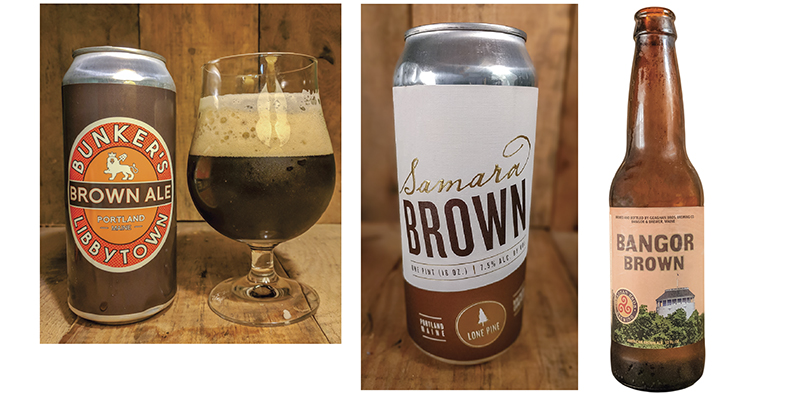
Bunker Brewing’s Libbytown Brown Ale is an espresso brown with notes of dark chocolate. Photos: Dave Patterson.
“We all love IPAs but there’s something great about leaving the hops in the background and really letting the malt character of a beer shine,” said Bunker brewmaster and owner, Chresten Sorenson, when asked what inspired the addition of a brown ale to Bunker’s portfolio.
The first words that come to mind when describing Libbytown Brown Ale are luscious and decadent. Descriptors I never imagined using for a brown ale. Ever.
Libbytown pours an espresso brown and emanates notes of dark chocolate and subtle roasted malts. Swishing a gulp of this brown ale around my mouth releases traces of cocoa nibs and brown sugar. The real pièce de résistance for this beer is its mouthfeel; it is so creamy and silky that it borders on a stout feel on the tongue. But the finish is all ale yeast and chocolate milk. Libbytown is the kind of beer all browns should aspire to be.
In addition to these fine brown ales from Foundation and Bunker, Maine boasts a number of other noteworthy browns. Dry-hopped with American hops, Bangor Brown Ale from GEAGHAN BROTHERS BREWING will satisfy beer lovers looking for a hopped-up brown. The new ownership at GEARY’S BREWING has released a brown ale lush with molasses notes and a clean finish. And Samara Brown from LONE PINE BREWING clocks in at seven percent, brewed with coffee beans from Bard Coffee in Portland.
Maine brewers have shown that the brown ale is kind of like that nerdy girl in an ’80s movie who takes off her glasses and is suddenly transformed into a total babe. As the winter months inspire you to seek malty brews, reach for one of Maine’s beautifully crafted brown ales to see what you’ve been missing.
— Text: Dave Patterson. Dave is a novelist and freelance writer from Cape Elizabeth with a mighty thirst for craft beer.
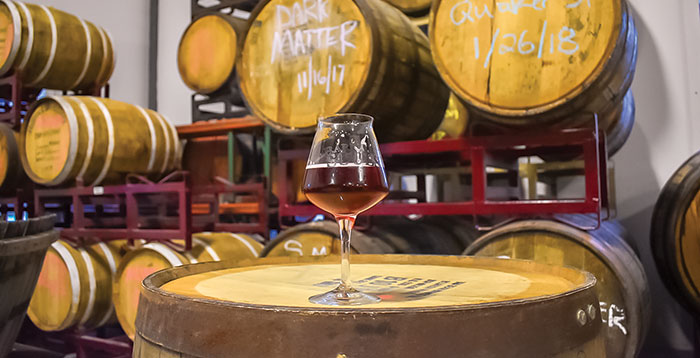
The Dark Heart of the Wood
While the concept of using wood as a primary vessel for beer making isn’t novel, it certainly isn’t in fashion these days.

Jesse Koelker pours a blended beer sample
aged over pistachios for sampling. Photo: Matthew Brown
Chris Schofield, brewer and part owner of Barreled Souls Brewing Co. in Saco, took some time with me to discuss his unique approach to brewing – using only wooden barrels to ferment his beers.
“It’s complicated, and there’s definitely more risk than working with stainless, but I believe it makes better beer and I managed to convince my partner and our employees, so here we are,” he said. Perhaps that’s why his brewery has undergone expansion and has gained a reputation for a lot of interesting beer choices of late.
The use of wood as a medium in brewing goes as far back as beer itself, but the role of the barrel has undergone a resurgence here in Maine. Intermingled with the vast stainless-steel vats and piping that one will see on nearly any beer tour, more and more barrels are being used as vessels to impart flavor, aroma, and mouthfeel to the beers coming out of the Pine Tree State.
Assistant cellarman at Barreled Souls Jesse Koelker and Justin McNelley showed me around the newly fashioned brewhouse in late August. After quaffing a few unique blends (aged over pistachio nuts, no less) they both expressed their love of barreled beers. “It’s the aroma and the flavor of what was in the barrels, and now the beer, that I love . . . people think a barrel-fermented IPA is strange, but we like it a lot,” said Koelker.

55-gallon wine barrels hold fermenting beer at Barreled Souls. The buckets above the barrels
act as yeast harvesting devices and airlocks.
Photo: Matthew Brown
Barrel use for primary fermentation, or secondary conditioning, can enhance many aspects of beer or lend itself to risks with contamination. Schofield went on to remark that “the challenges have mostly had to do with essentially inventing the process. Not inventing barrel fermentation itself . . . but inventing, for Barreled Souls at least, processes, methods, equipment, and a production facility to make it all work. There’s been a lot of trial and error, but as of today, four years and almost 1,000 batches in, we’ve got it fairly figured out.”
The influence of wood can change the flavor of a beer drastically. Each has its own characteristics that can even alter the fermentation occurring in a barrel. The type of wood, where it came from in the world, what it was used for prior to holding beer, and the barrel’s maintenance history, are all considerations in the process.
For example, if the barrel was originally used for a distilled spirit, then initial beer introduction can have a very powerful flavor of the original spirit. If there is char inside the barrel, it can act as an agent to help clarify the beer through a small amount of filtration, as well as mellow a beer’s sharp bite, while impacting a rich, earthier note. Some barrels that housed wines will react differently and can grant fruitier tangs or even spice notes like vanilla and cinnamon.
The environment within a barrel can also be exceedingly complex. In fact, many of the barrels for farmhouse and wild style ales can create a sustained biome within the wood itself, allowing spontaneous fermentation for many years. Often this is used in many unique Belgian styles like lambic and geuze and the  bacterial cultures in the barrels often impart a terroir that can be unique to a brewery. Cellarmen are often employed to help care for, and to assist with, blending of many barrels, since creating a uniform flavor year after year is a uniquely challenging task. It is not uncommon for some sour beers to be aged for years in oak casks or barrels before being blending and bottled for consumption.
bacterial cultures in the barrels often impart a terroir that can be unique to a brewery. Cellarmen are often employed to help care for, and to assist with, blending of many barrels, since creating a uniform flavor year after year is a uniquely challenging task. It is not uncommon for some sour beers to be aged for years in oak casks or barrels before being blending and bottled for consumption.
And finally, there is one other factor that brewers with traditional systems don’t have to worry about: the cleanliness of the barrel itself. While stainless-steel can be scrubbed, chemically scoured, boiled, and otherwise sterilized to make consistent product over and over, if a barrel breaks down or becomes contaminated, it is no longer useful and often repurposed into a kitschy Adirondack chair or bar stool. Brewers must be vigilant in how they maintain their assets, or they stand to lose potentially expensive product to carelessness or just being unlucky. “I’ve had to dump entire barrels of our Stay Puft,” remarked McNelley, “but when something bad gets into the barrel, you can’t get it out.”
Provided it was maintained correctly, barrel aging and fermenting beer can change the entire product you drink from something commonplace to something uniquely inspired. As you select your next craft brew this fall, try something touched by a barrel’s influence and see how it strikes you. You may find yourself pleasantly surprised.
— Text: Matthew Brown. Matt is a Certified Beer Server, a member of the American Homebrewers Association, and recently studied brewing in Belgium. He lives and works in Portland.
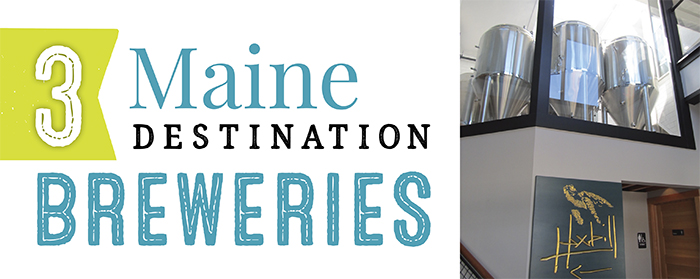
Blaze Brewing • Mast Landing Brewing • Sebago Brewing
Beer tourism has recently become a phrase in Maine’s marketing and economic vernacular. Maine visitors and residents alike plan day trips and vacations with an itinerary built specifically around brewery visits. With more than 110 breweries operating in the state, and one of the highest concentrations of breweries per capita in the country, Maine is on the forefront of the world of “Beercations.” This feature is the beginning of an ongoing segment we call “Destination Breweries.” These are chosen breweries whose town, location, atmosphere and ambiance of tasting room, and of course, amazing beer are what we love.

Photo courtesy of Mast Landing Brewing Co.
Camden gets its first harborside microbrewery
Camden, Maine has a lot of natural jewels—the nearby Mt. Battie, a stunning harbor, and now, with the summer opening of Blaze Brewing Co., another showpiece—a harborside microbrewery with bold American-style beers on tap.
In the summertime, the town is bustling with visitors who come for the slower pace of life, whether it’s taking in some of the eclectic family-owned shops, going out for a sunset sail on a three-masted schooner, or enjoying some of the freshest seafood the area is renowned for.
Kurafuto (the Japanese word for“craft”) is the latest pub to complete restaurateur Matthew Haskell’s trifecta of combining two restaurants and one microbrewery all in one location at Bayview Landing. Both Hoxbill, Haskell’s fine-dining establishment and Karafuto, a small counter-service restaurant, will share the brews coming out of the glass-enclosed production room that links both restaurants.
On a sunny day, there’s nothing better than sipping on their inaugural #12, a double IPA and sampling the freshest oysters and clams from the raw bar while out on the stylish deck overlooking the harbor or made-to-order noodles, sushi, and sashimi out in the beer garden.
Haskell, who favors Belgian styles, is excited to work with his brewers to roll out four or five palate-pleasing summertime brews such as a Ginger Witbier, a hoppy IPA, and a Saison.
Additionally, this August, Haskell plans to open Blaze Urban Pizza next to the waterfront concerts facility in Bangor. This counter-service fast-casual restaurant and tap room will feature gourmet wood-fired pizza and Blaze Brewing Co. as the in- house microbrewery. This summer is looking blazin’ hot with cool brews.
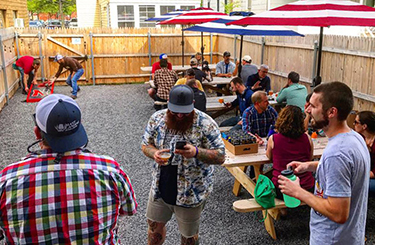 Extremely Tasty Brews Await at Mast Landing Brewing Co.
Extremely Tasty Brews Await at Mast Landing Brewing Co.
Portland may take the crown for having more breweries per capita, but it’s worth tracking off the beaten path over to one of its suburbs, Westbrook, to experience Mast Landing Brewing Company at 920 Main Street.
Stroll along the Westbrook River Walk overlooking the The Presumpscot River, before hitting shops and restaurants on Main Street.
Then, check out the microbrewery—Westbrook’s first—which opened just three years ago in an industrial building with the intent to carve out an ultra-local niche. Its name, a nod to Maine’s rich nautical heritage, boasts a number of refreshing, crisp pale ales such as the Tell Tale, their flagship tropical pale ale, Little Choppy, the perfect summer session ale or Shorts Weather, packed with peaches and apricots to enjoy out on their casual outdoor beer garden with picnic tables and umbrellas. Don’t miss their new “Small Drops” series of one-off beers, brewed in 30-barrel batches that push the boundaries of craft beer. Come in for a taste, and grab cans to go!
Sebago Brewing in Gorham for brewery tours, tastings, and wood-fired fare
Why is Main Street in Gorham the place to be? It’s where you’ll find Sebago Brewing’s new Destination Brewery, the perfect spot for craft beer enthusiasts and families alike.
The Tasting Room has a full-service open kitchen serving wood-fired pizza, creative sandwiches and unique entrees, all focused on locally sourced ingredients. Naturally, the menu is beer-centered and changes frequently.

Photo courtesy of Sebago Brewing Co.
The Tasting Room features 16 taps with Sebago favorites such as Simmer Down and Frye’s Leap IPA – and you might catch a small batch from the new pilot brewhouse. (If you prefer a different beverage, Sebago also offers regional distilled spirits and select wines.) Guests are welcome to choose their own flight and samples. Pours and prices vary depending on the day.
The highlight of your visit may be the free brewery tour. There are several tours a day, where tour guides share the history of Sebago Brewing and then walk visitors through the brewing process – the milling area, the fermenters, the canning line, and more.
The Destination Brewery is open Sunday-Wednesday from 11 a.m. – 9 p.m., and Thursday – Saturday from 11 a.m. – 10 p.m. Sign up for a free tour at the Tasting Room. (Tour scheduling will be available online soon.)
Visit sebagobrewing.com to find out more about Sebago Brewing Company’s events and beers.
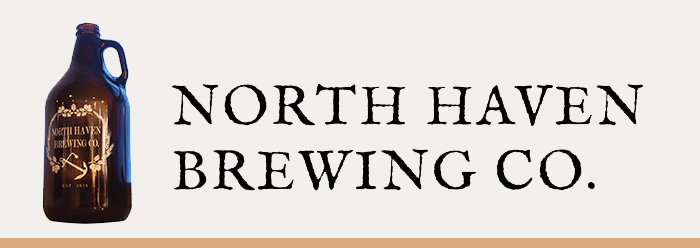
An Island Brewery that’s Worth the Trip
Why should the mainland have all the fun?
This summer, another Maine island boasts a brewery that’s only accessible by plane or boat. Visitors to North Haven can now enjoy balanced, English-style beers from the comfort of a funky basement space with a view of a 130-year-old boatyard.
 North Haven Brewing Co., which celebrated its first birthday in November, was founded by Ben and Elizabeth Lovell, siblings who grew up on North Haven, and Ben’s childhood best friend, Jesse Davisson, a life-long islander.
North Haven Brewing Co., which celebrated its first birthday in November, was founded by Ben and Elizabeth Lovell, siblings who grew up on North Haven, and Ben’s childhood best friend, Jesse Davisson, a life-long islander.
Ben and Elizabeth left to attend Bowdoin College, and chose to return to the island as adults. The brewery got its start when Ben and Jesse decided to see how far they could take their home-brewing hobby.
“As Jesse and I were both fishermen, we decided that we’d brew beer because we had the whole winter off,” Lovell said. “We just kind of kept at it, kept brewing, kept taking classes … one day we were sitting on the beach, Liz and I, and she was just like ‘we should really sell this.’ ”
After three years of planning and building out the space underneath the newly renovated Calderwood Hall (also home to several apartments, a film production studio and the Calderwood Hall restaurant) North Haven Brewing Co. opened for business in the winter of 2017.
 Locals and tourists alike flock to North Haven Brewing Co. for the beer selection, which ranges from regular offerings such as Keeper (a hoppy IPA), Highliner (a crowd-pleasing pale ale), and Barrel Stove Brown Ale to more esoteric one-offs featuring local ingredients, which can be enjoyed in the tasting room or taken home in refillable growlers. Restaurants on North Haven, Vinalhaven and Rockland have featured North Haven Brewing Co. beers on tap as well.
Locals and tourists alike flock to North Haven Brewing Co. for the beer selection, which ranges from regular offerings such as Keeper (a hoppy IPA), Highliner (a crowd-pleasing pale ale), and Barrel Stove Brown Ale to more esoteric one-offs featuring local ingredients, which can be enjoyed in the tasting room or taken home in refillable growlers. Restaurants on North Haven, Vinalhaven and Rockland have featured North Haven Brewing Co. beers on tap as well.
“We had a couple of one-offs, like AM Stout, that people really love,” Lovell said. The coffee stout was a collaboration with between the brewery and 44 North Coffee, located on Stonington Island. Another one-off, Sailor’s Warning, a red ale, featured North Haven-inspired rose hips.
The brewery’s social scene is another reason for both locals and tourists to visit. The space hosts weekly pub theology and occasional live acoustic music. Curious passersby come in for the first time to check out the operation, which features stainless steel vats behind a glass wall for easy viewing.
“It’s fun for us to have people come in and see the equipment right there behind the glass,” Lovell said.
“It’s a conversation starter,” Liz added.
North Haven Brewing Co.’s tasting room hours can be found on their website www.northhavenbrewing.com
— Text: Courtney Naliboff. Courtney lives, writes, plays music, teaches and parents on North Haven island.

Inside the Hop Pilot Programs of Maine Breweries
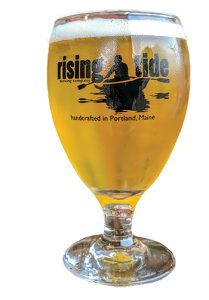 These days, the nuclear rate of innovation among Maine brewers is part of what makes our craft beer industry so explosive. Brewers work tirelessly to craft the next line-inducing, palate-slaking beers for ravenous fans. Whether it’s experimenting with wild yeast, unique barrel-aging techniques, or specialty ingredients, Maine brewers are continually pushing at the boundaries of craft beer.
These days, the nuclear rate of innovation among Maine brewers is part of what makes our craft beer industry so explosive. Brewers work tirelessly to craft the next line-inducing, palate-slaking beers for ravenous fans. Whether it’s experimenting with wild yeast, unique barrel-aging techniques, or specialty ingredients, Maine brewers are continually pushing at the boundaries of craft beer.
No sector of innovation receives more attention, or has a bigger payoff for that matter, than brewing the next chic IPA. Like it or not, hoppy beers are the behemoths driving the craft beer industry to such stratospheric heights, and brewers are on an arms race to forge cutting-edge IPAs.
To take their hop-game to the next level, a number of Maine breweries feature a hop pilot program to experiment with hop varieties and combinations of hops. Essentially, these hop pilot programs are R & D that you and I get to drink.
One local hop pilot program that has been satisfying my lupulin cravings is Mast Landing Brewing Co.’s Green-to-Green small batch series. 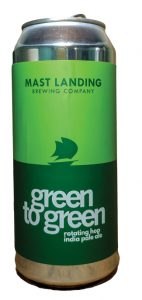
Mast Landing President Ian Dorsey explained that the Green-to-Green program offers a number of benefits in addition to research and development.
“It allows us to consistently offer new and exciting beers to our customers with the ultimate hope of collecting feedback to help steer our future production schedule,” Dorsey stated.
When customers offer a resounding “Yes!” about a beer in the Green-to-Green series, Dorsey and his brewing team at the Westbrook brewery take note.
“Batches that perform exceptionally well end up being pulled out of the program as their own stand-alone brands. This is where Saccarappa IPA and Dash IPA originally started,” he explained.
Not only do beer drinkers get to sample forward-looking IPAs in each new batch, they can also help create new beers on the market when giving feedback.
One of the most important purposes of the Green-to-Green series that Dorsey noted was its benefit to his brewing team. He explained that the hop pilot program “allows brewers to exercise their creative muscles and keep them pushing the boundaries of the discipline.”
If you know anything about brewing beer, then you understand it’s akin to baking bread—these hop pilot programs keep brewers from having to bake the same loaf everyday. And inspired brewers equal blissful beer drinkers. It’s simple math.
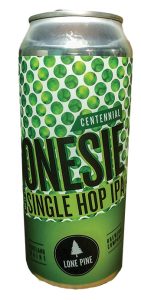 Another popular hop pilot program is Soundings from Portland’s Rising Tide Brewing Company.
Another popular hop pilot program is Soundings from Portland’s Rising Tide Brewing Company.
The East Bayside brewery has long been dedicated to precise science and quality control techniques to produce their palatable line-up of beers. So, it was no surprise that when I reached out to Rising Tide co-owner and brewmaster, Nathan Sanborn, his answers reflected this science-minded ethos.
“The Soundings beers get a ton of play in our sensory program, so that we can collect as much sensory data on each beer as possible, including its performance over time. We collate that data against the technical brewing data and recipe information, and use that information to apply to future or existing recipes in our portfolio,” Sanborn stated. “We are always trying to push our craft forward and make better beer each week so this data is invaluable.”
Technical answers like this illustrate why Rising Tide’s hop pilot program has produced so many exquisite iterations. There’s a deserved buzz around each small batch release.
Unlike many hop pilot programs where the grain bill and yeast strain of the beer remain the same, while only the hops change, Sanborn and the Rising Tide team take a more holistic approach to constructing each new recipe of Soundings.
Sanborn explained, “We also use the Soundings series to try out different base and specialty malt combinations, as well as other raw, pre-gelatinized, or malted grains.”
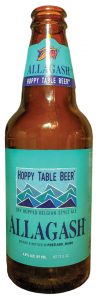 Through the monthly release of Soundings, Rising Tide gets surgical with its use of ingredients in every step of building an IPA. Most importantly, each batch has a unique flavor profile and pushes the conversation on IPAs forward for brewers and drinkers.
Through the monthly release of Soundings, Rising Tide gets surgical with its use of ingredients in every step of building an IPA. Most importantly, each batch has a unique flavor profile and pushes the conversation on IPAs forward for brewers and drinkers.
There are simply too many other hop pilot programs to list here, which just shows the tireless innovation and embarrassment of riches in Maine’s brewing community.
Here are a few more, however, that are always on my radar. Lone Pine Brewing features a program called Onesie: a series of single-hop IPAs focusing on the unique characteristics of one hop per batch. The hop wizards at Battery Steele Brewing have dubbed their hop pilot program Onsight—a series turning out some beautiful IPAs. And, in one of Maine’s first hop pilot programs, and one of the best, Sebago Brewing annually releases Hop Swap.
If you have yet to delve into Maine’s diverse hop pilot programs, the time is now. Who knows? Your feedback might just help create the next big IPA.
— Text: Dave Patterson. Dave is a freelance beer writer, novelist, and lover of all things Maine beer.
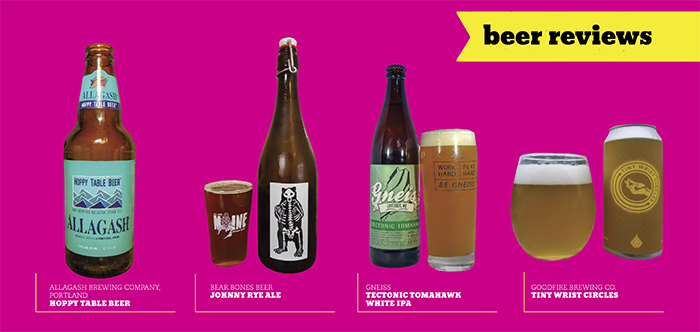
Summer’s Session-able Beer Reviews
Allagash Brewing Company, Portland
Hoppy Table Beer
4.8% ABV
The orchestra of bright flavors packed into a bottle of Hoppy Table Beer refreshes the senses like a cool summer evening. It pours a sun-colored hue with a frothy head of tiny bubbles. The aroma is an interplay of ripe mango and pine needles from the Comet and Azacca hops used in dry hopping, along with subtle notes of lemon grass from Allagash’s signature use of coriander. Each sip releases grapefruit and fresh cut grass flavors over the palate. It finishes on the back of the tongue with crisp notes of citrus fruit, subtle pine flavor, and fruity esters from the Belgian yeast. Hoppy Table Beer is the perfect compliment to whatever summer brings your way.
-Dave Patterson
Bear Bones Beer
Johnny Rye Ale
4.3% ABV
Bear Bones, though small in size, is big on flavor. Amber-mahogany in appearance, Johnny Rye Ale has pleasant aromatic notes of caramel. Featuring local malt from Blue Ox and Maine Malt House, this beer’s clean mouthfeel, crisp body, and 4.3% ABV make it perfect for summer splendor. Mild in hop character, the ale’s sweetness balances well with the rye’s inherent spice, which gives you a distinct zing at finish. Whether you’re strutting through Lewiston or vacationing in Bridgton, this is a solid beer for any occasion.
-John Breerwood
Gneiss
Tectonic Tomahawk, White IPA
6.7% ABV | 75 IBU
Since opening in 2013, Limerick’s Gneiss Brewing Company has been crafting unique beers that pay homage to German brewing tradition, without necessarily being slavish to style. Tectonic Tomahawk is a testament to the brewers’ creativity, marrying a traditional German hefeweizen (fruity, spicy, and hazy) with an India Pale Ale. Tectonic is hopped exclusively with Tomahawk hops, in layers in the boil, and again in the secondary. The resulting hybrid of the ascendant American IPA and traditional Weissbier is a surprising treat; citrusy, herbal hops paired beautifully with the estery fruit and clove of a hefe.
-Josh Christie
Goodfire Brewing Co.
Tiny Wrist Circles Saison/Farmhouse Ale
4.4% ABV
If you are warming up to Saisons again, this beer is a game changer in the session category. As summertime sits on the horizon with warmer temperatures and outdoor recreation on the rise, this is a beer to have on hand to enjoy it all. It pours a hazy, deep amber color with a tall white head that fades quickly. It has an earthy and slight citrus aroma with a smooth and soft mouth feel. This saison has a nice clean palette with a crisp and refreshing finish, that leaves you wanting the next sip. Tiny Wrist Circles takes six weeks to brew, so it has limited releases throughout the summer in cans but can be found on draft pretty consistently. Don’t miss this one!
– Stanley J. Rintz

Connecting with Home Brewers in Maine
Say you’re new to homebrewing, or new to Maine and you want to connect with other beer and brewing enthusiasts, but don’t know where to start. If your first inclination is to Google where groups are gathering in the state, you’ll get lost down the rabbit hole, for there is not one statewide Maine Homebrew Club.
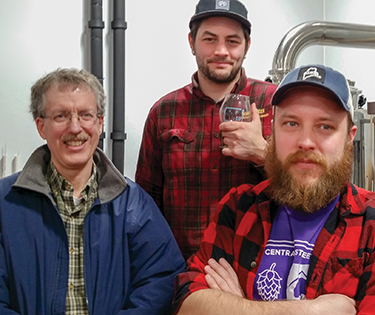
(L to R) Dave Rocker (winner of Maine Homebrewers Competition), Jared Lambert (Head brewer at Bangor Beer C.o), and Josh Parda, owner of Central Street Farmhouse. Photo courtesy of Dave Rocker.
We turned Central Street Farmhouse in Bangor, which organizes the largest annual Maine Homebrewers Competition in the state, to find out “Where The Beers Are.”
Josh Parda, a long-term employee turned new owner said, “There are a number of ways people who are new to brewing find each other. Or, maybe they’ve been brewing a long time, but want to hang out with other brewers. Often, they’ll come into a store like ours and just ask us who to reach out to. A few of the larger groups have websites and Facebook pages and regular meet ups.”
Homebrewing clubs in Maine are popping up as fast as the breweries themselves. They can be as simple as a bunch of guys and gals hanging around in someone’s garage shooting the shizzle and sampling new beers. Or some choose to communicate through closed Facebook groups and email lists while others operate as formal organizations with officers, bylaws and minutes.
To date, there are three major homebrewing organizations spread out around the state: Home Brewers of Greater Bangor, Maine Ale & Libation Tasters (MALT) in central Maine (Augusta/Waterville area) and Portland Maine Mashing Maineiacs.
A smattering of smaller groups and clubs exist in various areas around the state, which can most likely be found by searching Facebook. The big three also host, (along with Central Street Farmhouse) an annual homebrewing competition, which is another excellent way to connect with other beer enthusiasts.
Sam Canders, president of Home Brewers of Greater Bangor, reiterated what Parda suggested—that the best way to find out where the nearby clubs and gatherings are is to buy locally from homebrewing supply stores. “Especially for people not on social media or Facebook, go talk to the staff behind the counter, because they are likely to know what’s going on and who is getting together,” he said.
Canders said that his organization is very keen on creating a Maine Homebrewers Guild, essentially a network amongst all of the various brew clubs and organizations with the collaborative goal of creating a cohesive movement. “Our club is working on legislation to create a homebrewing exemption in the state of Maine, among other initiatives, such as a Maine Homebrew Festival,” he said. “Our intent is not only to make our own club stronger, but also to make other clubs in the state better as well. After all, a lot of the commercial brewers opening today started out as homebrewers.”
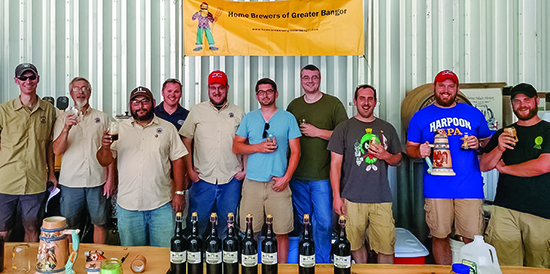
The Portland Mashing Maineiacs have been in existence for 11 years, have around 25-35 active members, and come to monthly meetings with more than 100 informal members who are networked by an email list. “We’re fairly informal,” said co-founder Chuck Warner. “It’s more of a social club and we have people come from as far north as Brunswick and as far south as the Sanford area. People can always sign up on our email distribution list on our website to find out about the meeting dates and other activities. We also host Brew Days, usually at someone’s house, where people can bring their equipment and we brew together.
To find out more about the major clubs around the state and to get a better idea of their “club vibe” visit homebrewersassociation.org and type “Maine” in the search bar.
— Text: Kay Stephens. Kay loves beer and hiking and often combines the two. She is an author and an arts and entertainment freelance writer whose work has appeared in a number of Maine newspapers and magazines.

The Maine Brew Trail Expands with 7 New Breweries Across the State
Plus 16 more opening this spring and summer.
We have barely flipped the 2018 calendar and we can already count 16 upcoming new breweries just champing at the bit to open. This, on top of the seven recent openings in the last quarter of 2017! We can’t blame you if your head is spinning, trying to keep track of them all.
According to the latest breweries joining the Maine Trail, finding a business name that hasn’t already been taken is becoming increasingly more difficult. There also seems to be a trend with varying styles pulling away from the highly popular New England IPA, so breweries can provide “beer for everyone.” Using barrels from Buxton’s River Drive Cooperage is going to allow three of these brewers to experiment with some interesting flavors in the months to follow. Be on the lookout for English styles aged in whiskey barrels, a Russian Imperial Stout, and Belgian styles aged in apple brandy or gin barrels.
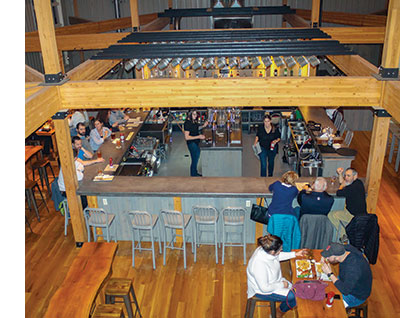
Nonesuch River Brewing
A new tasting room, extended hours, increased capacity, patio seating, outside distribution, and brewing/fermentation classes are among the goals in 2018 shared by the recently opened breweries below. Some of the coastal breweries have even expressed interest in finding a more creative way to link together, perhaps in the form of a brew boat tour.
The following breweries have just opened their doors this season:
NONESUCH RIVER BREWING honors the river that runs through the town, “connecting all the communities” in Scarborough. Opened in September 2017, by owners Jeff Gambardella, Michael Shuler (brewer), and Tim Boardman, NRB offers sessionable ales with low ABVs, making it easy to drink when paired with their handcrafted food.
The beautiful wooden brewpub is home to the 15BBL brewhouse, as well as a large two-story tasting room and restaurant, and offers an outside patio. The “mug club” steins were made from the clay dug during construction by a local artisan. Shuler was a homebrewer for 20 years prior, creating recipes in his garage. NRB is excited to partner with Nappi Distributors for can distribution soon in 2018.
Portland
GOODFIRE BREWING COMPANY is the newest addition to #DrinkAnderson, the collaborative hashtag promoting four adult beverage businesses, all located in the same building in the East Bayside neighborhood. Upon opening in November 2017, GBC has concentrated on tasty IPAs, but has since added a crisp fresh pilsner that is a must try. The tasting room is family friendly, offering various board games as well as ample space to gather and plans for outside seating. Entrance is in the back; signage is coming in 2018!
The crew of four handling operations is made up of Dr. David Redding (owner), Gordon Jones (brewer), Kelly Scharf (GM), and Chris Beth (Distribution Engineer). Jones, a prior homebrewer, gave props to industry influencers such as Dirigo, MBC, Bissell, Foundation, and Sebago for their guidance in allowing him to shadow their operations before installing his own 15 BBL system.
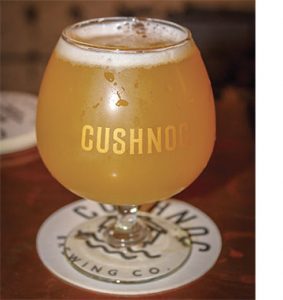
Photo: Cushnoc Brewing Co.
Monmouth
GRATEFUL GRAIN BREWING COMPANY offers a cozy tasting room in the Tacoma Lakes region and is a must stop on your way through central Maine. Owners Trevor Knell (brewer), Tom Langlois, Ryan Cote, and Nick Knowlton offer five taps using their 1BBL system. Plans for 2018 include increased parking, an extended weekend schedule, an outside patio, and the addition of food trucks. I highly recommend their juicy grapefruit bomb, The Experience. If you see it on tap, grab one; it sells out fast!
Gardiner
TWO GRAMPS BREWING was created by Joe and Kristy Gould in October 2017. While there are a few mainstay offerings, like Moosail and Nostalgia, Joe loves to have fun with all the others. The signage is by far the most creative I’ve seen, many tied to local landmarks or events, such as the Chadarny Maple Brown Ale that will be released for Maine Maple Sunday or the Zesty NU Bridge, which pokes fun at the anticipated angst the two new bridge constructions sites may bring to Gardiner commuters. The tasting room is a great place for locals to enjoy Trivia Tuesdays, live music, and craft burgers with plans for outdoor seating.
Augusta
CUSHNOC BREWING CO. is proud to be part of the exciting revitalization happening down on Water Street. Greeted with a smile from GM Casey Hynes, you’ll find the ambiance a mix of mosaic tile, tin tap backdrops and various levels of seating, all under the glow of beautiful hanging bulbs. Owners Tobias Parkhurst, James Bass, and brewer Chris Geerlings wanted to make sure there is “beer for everybody” by offering varying styles of craft beers such as a Kölsch style ale, an American IPA, a Belgian IPA and a Belgian Style Grisette. The “Born on the Kennebec” series include daily mainstays, while the “Defend the Fort” series offer small batches, which turn over quickly.
Exciting rollouts for 2018 will include the addition of a tasting room in the basement and bottling their beers for distribution.
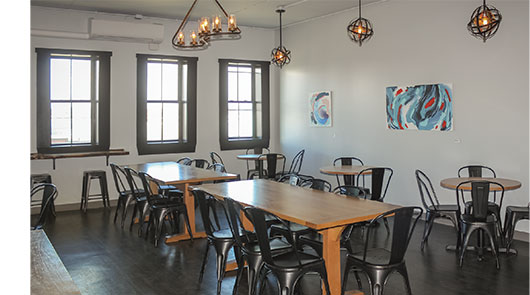
Goodfire Brewing’s extra seating area
Ellsworth
FOGTOWN BREWING COMPANY was opened in December 2017, by owners Ian Heyse and Jonathan Stein (brewer) as a family-friendly community gathering spot. Styles vary based on what Ellsworth likes, including a Pilsner, a Lambic, two sours, and American ales and lagers. The use of gin and tequila barrels for aging piqued my curiosity as a must try. They designed and built the tasting room with reclaimed lumber and bricks themselves and provide the perfect place for local artists, musicians and educators. If you’re on your way to Acadia, you must stop by and check it out.
Fort Kent
FIRST MILE BREWING COMPANY was created by five home brewers, all part of a brew club that met to sample each other’s creations. If you ever needed a reason to travel north, this is it. Whether you’re in town to see America’s First Mile or for a day of kayaking Eagle Lake, FMBC is worth checking out! With eight taps, I’m told “every beer has a story.”
Since opening in November 2017, FMBC is already talking about increasing their capacity and finding a way to incorporate more local ingredients into their brews. Community food stops have created menus exclusively for FMBC (or you can bring your own in) during their Open Mic Nights.
— Photos & Text: Kim Benjamin. Kim is a craft beer enthusiast who believes in supporting local and loves to engage her friends and colleagues in the latest industry chatter.
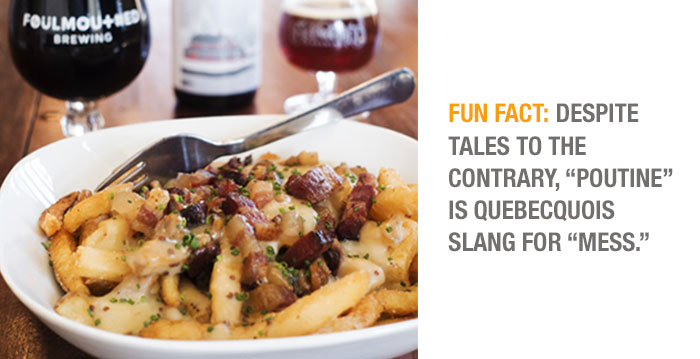
Poutine: Penultimate Comfort Food at Foulmouthed Brewing Company
From the time chef Dan Lindberg was a child, he has been an innovator in the kitchen. “I helped my grandmother cook our family’s meals,” Lindberg said, “but one afternoon, I didn’t like what she was preparing, so I snuck in a bit of dish soap. The dinner was inedible, so we sent out for pizza.”
There were consequences, of course, some form of punishment being one, but another was his career choice. Having cooked in the Pacific Northwest and more locally at the high-end Hugo’s in Portland, Dan Lindberg has found a home at Foulmouthed Brewing Company in the Knightsville neighborhood of South Portland.
On his menu is the popular dish, Poutine, a dish invented in the 1950s in Quebec. According to the Canadian Encyclopedia, Poutine was served in snack bars and diners throughout the dairy-rich section of Centre du Quebec, where cheese curds were plentiful. Although several eateries claim to have “invented” Poutine, the end result—salty French fries topped with hot, brown gravy floating with melty cheese curds—has become a darling of Americans too.
“Poutine has turned out to be one of our most popular dishes,” Julia Dilger said, co-owner with her husband Craig, of Foulmouthed Brewing. “That, and our nachos, and grilled cheese sandwich.” Asked if she knew that Poutine was Canadian, Julia said, “I did, but I’m from New Jersey, and down there we had a version of it we called ‘Disco Fries’.”
Foulmouthed Brewing celebrated its first anniversary this past June. Julia Dilger gave up her teaching career and her husband Craig traded in his work as a photographer to “follow their bliss” and open a brewpub. “We thought at first we would rent out the kitchen to someone who would provide our food, but we finally decided we needed to have some oversight and control over that aspect of the business,” Julia Dilger said. “That’s when we asked our friend Dan Lindberg if he would be interested in running it.”
As for the brewery, Julia and Craig hired Craig’s homebrew partner Bill Boguski to take over as brewmaster. Craig had been homebrewing for years, while doing one-day stints at Smuttynose Brewing Co., Oxbow Brewing Co. and Marshall Wharf Brewing Co. until he became head brewer at Lively Brewing Co. At Foulmouthed, brewing tends to be a collaboration. Chef Dan “helped figure out just how much basil to put into a basil saison we brewed that was the winner of a local homebrew competition,” Julia Dilger said. “And Dan had an idea to brew a Gose made with kosho, a Japanese paste made of yuzu, salt and chili peppers.”
Back in the kitchen, Dan makes the Poutine in three steps. First he simmers pork bones with aromatics like onion, garlic, carrot, celery and herbs for four hours. From the resulting stock, the gravy is made with a bacon-fat roux and more spices. Potato “batons,” as Dan calls them, are cut from Norwis or Russet potatoes, soaked in ice water, frozen overnight, then fried as needed. Cheese curds are from Maine’s own Pineland Farms.
“We recommend pairing it with Ice Scraper, our barrel-aged barley wine or Vanilla Cream Stout, our stout-aged with vanilla, which we describe this way:
British Maris Otter malts provide the base of this smooth, roasty stout. Oats, flaked barley and lactose make it delightfully creamy and a touch of vanilla rounds it out.
Enjoy the perfect winter comfort food “mess” created by the Quebecois. Merci!
— Text: Kate Cone, author of What’s Brewing in New England: A Guide to Brewpubs and Craft Breweries, published by Down East Books. She cooks with beer frequently at her home in Waterville, Maine.
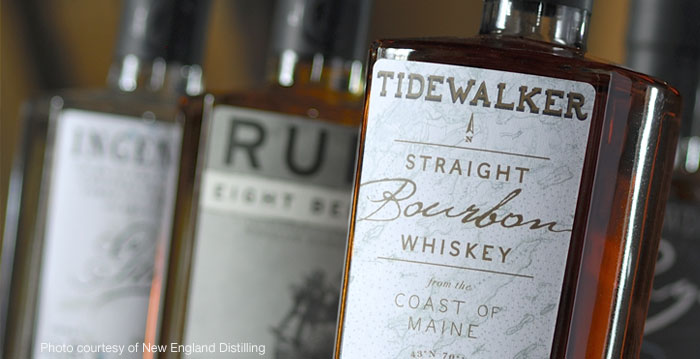
The Tale of the Tidewalker
The name Tidewalker is mysterious enough. Google it and you’ll find very little about what it means. In an overactive imagination, it evokes some kind of ghostly wraith trudging upon the seas. But, in actuality, the crew of the Portland-based New England Distilling found this logging term to be the perfect moniker for their latest bourbon.
Ned Wight, owner and distiller of New England Distilling said the name for their new bourbon was named for an important element of Maine history.
“I think we were grilling out for lunch and had a couple of beers then just started brainstorming about what we’d want to name it,” he said. “It’s a logging term that refers to the logs and snags that would make it down river and sort of float around the inner tidal zone.”
Apart from their Gunpowder Rye whiskey, which also has the rugged outdoors attached to its name, Tidewalker has a nice, toasted corn character, with a lot of caramel, vanilla, maple syrup, and pitted fruit flavor, reminiscent of apricots. “Makes me a little thirsty just thinking about it,” said Wight. You can imagine this bottle being passed around an old logging camp after a long day on the river, while the camp cook hauls a cauldron of baked beans out of the fire pit.
“You know, it’s funny, when you think of bourbon, you think of Kentucky, or rural inland areas,” said Wight. “Here we are in Portland and a large character of bourbon is wood, so we wanted to tie the inland, water and wood together with a name that completely fits and I think Tidewalker does that. I don’t know what it is about that word, but it just resonates with people when they hear it.”
— Text: Kay Stephens. Kay loves beer and hiking and often combines the two. She is an author and an arts and entertainment freelance writer whose work has appeared in a number of Maine newspapers and magazines.
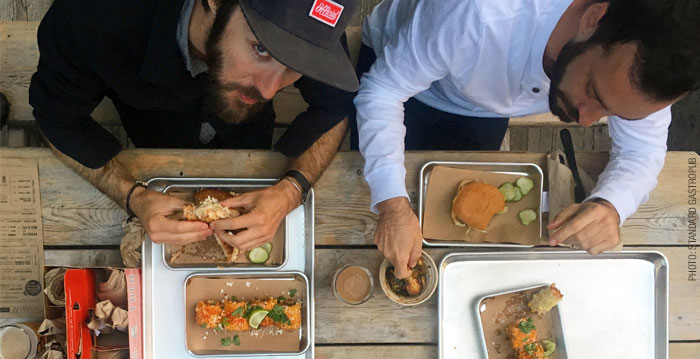
Route 302: The Expressway to Tasty Maine Beers and Beyond
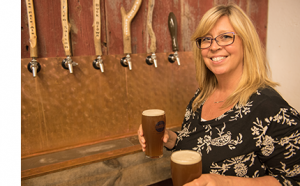
Photo: Saco River Brewing
Whether in search of barrel-aged and blended sours with wild fermented and mixed culture beginnings, or hops and hops and hops, chances are this pastime will eventually take us all down Route 302—to or from—the New Hampshire border.
Keen to this new traffic pattern, many businesses have taken to accommodating the wants and needs of travelers along the 302 corridor. These bottle shops, breweries, pubs and bars are filling the void through western Maine. From fueling up for the journey to filling every last inch of the trunk—the next time you set out on tour, we’ve got you covered.
Starting on Forest Ave in Portland, sits RSVP DISCOUNT BEVERAGE, where you’re immediately struck by two things: RSVP’s overall beer selection and their CHILLED beer selection. RSVP has filled the entire side wall with beers and added 19 beer coolers to the back wall of the retail store. Stocking the latest beers from local Maine and New England breweries, all the way to Belgian ales made by Trappist monks, (as well as hard cider, wine and sprits) RSVP always has the adult beverages you want.
From Portland, enjoy a beautiful scenic drive through the towns of the Sebago Lakes Region where you come to Naples. A must stop here is the UMBRELLA FACTORY OUTLET (U.F.O.) Located in the Shop N Save shopping center on the corner of Rt. 302 and 35, the U.F.O. offers more than 2500 sq. ft. of liquor, wine and craft beer choices. From hard apple cider to seasonal brews, you’ll find them here. The store expanded in 2015 to add the Craft Beer Runway, which leads to the Lost Moose Campground tasting center, (offering wine and beer tastings). Open daily Mon-Thurs 9 a.m. to 8 p.m. and Fri-Sat from 9 a.m. to 9 p.m.
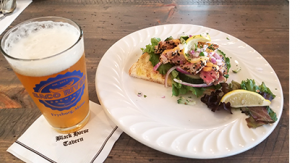
Photo: Black Horse Tavern
Next down the road in Bridgton is the BLACK HORSE TAVERN, a Klimek family-operated regional favorite dining spot, which has drawn people from all over the Northeast for the past 30 years. The reason is quite simply that is has consistently great food. The casual equestrian atmosphere makes you feel right at home as you enjoy local ingredients, the freshest seafood and Black Angus signature steaks and burgers. As our chefs have been schooled in different regions of the world, the Black Horse Tavern is very proud to create everything in house, including soups and desserts. Famous for our Danish Baby Back Ribs, we serve more than eight tons per year. Featuring eight rotating local craft beers on tap and a chef-inspired daily Specials menu, the Black Horse Tavern looks forward to serving you soon.
Also in Bridgton is the STANDARD GASTROPUB. Whether just passing through or going upta-camp for the weekend, be sure to stop in on your way. A casual beer and a bite here is quick and easy and everything is always fresh and from scratch. Shift gears and stay a while to work your way through the wall of brightly lit bottles and cans and indulge in a party of flavors with a few nightly specials from the kitchen.
Built into a renovated (but still operating) gas station, Standard Gastropub leaves dining concepts in the dust. Breaking the mold, this self-service fill-er-up offers customers a full-service experience at the table. Try something new and get an array of flavors for an affordable outing by ordering plenty of small dishes and sides to share and be sure to ask questions of the knowledgeable staff.
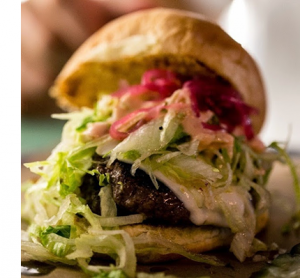
The Double Standard at Standard Gastropub
Show your day ticket or seasons pass from any mountain and get $1 off draughts and select items for Après Ski!
Drink. Enjoy an extensive beverage program at Standard Gastropub with around 300 craft brews, including many rare, limited, and hard-to-find selections from near or far. Fifteen draught lines are always revolving with a thoughtfully curated selection of the best beer locally available, including unique brews from away, off-beat wines, Saki and more.
Eat. Sample a concise daily menu full of dishes with a gourmet focus. Drawing culinary influence from street food around the globe, BBQ pits of the south, and west coast drive-thru style burger shops, Standard Gastro Pub strives to support local agriculture and artisans in the region.
If you are looking for a brewery stop in Bridgton, BEAR BONES BEER is releasing bottles of a blend in November rested with organic wild blueberries called Brett and Brad. This winter, patrons will be looking forward to Bear Bones Beer spruce tip dry sour, rested in a Maine Craft Distilling sprig gin barrel. In addition, the beer everyone is waiting for is the Tripel C.R.E.A.M., an 11% bourbon mash, which gets its first run on their bourbon barrels.
Stay tuned for other experiments in the works, including more sours to come. As for events happenings at the Bridgton brewery, look for live comedy every first Thursday of the month, trivia every Monday night. and live music on Saturday evenings.
Last, and certainly not least on 302, before you reach the New Hampshire border, try SACO RIVER BREWING in Fryeburg, co-founded by Mason Irish and Kevin Antonucci in 2015. Kevin was an owner of the Good Beer Store at the time and Mason was an avid homebrewer, who regularly bought supplies from the store. After starting a homebrew club over lots of conversation, the two decided to have a go at a commercial brewery in Fryeburg.
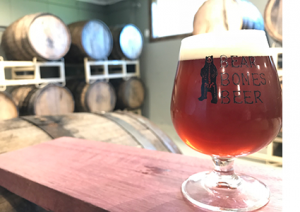
Photo: Bear Bones Beer
The taproom opened in July, 2016 in a building that formerly housed a sheet metal fabrication shop. The open concept and concrete floor was a perfect venue for both brewery and taproom. Designed to be a laid-back social environment connecting people from wherever they come from, the taproom’s rustic design contributes to an easygoing vibe.
Saco River Brewing produces many styles of beer. At least half are American style ales that are hop forward, including several IPAs and Pale Ales. Other styles that are regularly on tap include a Czech Pilsner, Belgian Saison, American Brown Ale, an American Porter, and that base Porter with the addition of locally brewed coffee. This winter, a Bourbon-aged version of Old Course Porter will be released in the taproom. When the taproom is not open, SRB’s beer can be found regularly at restaurants in Fryeburg, Bridgton, Cornish, Brownfield and Bethel.
The taproom is located just off Rt. 302 across the street from Jockey Cap, a 200- foot high rock formation that was created by glaciers and is now a famous Fryeburg landmark. Locals are a huge part of SRB’s success, stopping in regularly after work, and after recreation, which is why the majority of people in the Mount Washington Valley live here. Tourists visit year round, from summertime hikers, bikers, anglers, and river goers to winter skiers/snowboarders, hikers, and snowmobilers. Access via snowmobile is very easy from ITS 80, which runs through Fryeburg. Spur trails from the ITS lead into Fryeburg village and Saco River Brewing.
The Trade Trend
By land, sea, or river, much of Maine’s history is anchored in trade. While timber may no longer float down the Androscoggin; the beer business is booming and a new trade route has emerged. The path between southern Maine and the hills of Vermont now connects thirsty customers with big name brewers. These beer nerds began piling into anything on four wheels and setting out in search of the next, newest and best; often just to hurry up and wait (in line) for a chance at picking up as many shiny four-packs as they can fit in the trunk.
— Intro: William Holmes
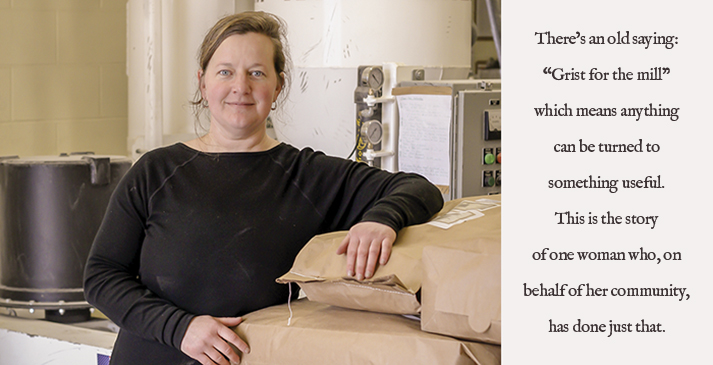
From Jailhouse to Brewhouse:
How Maine Grains became a devoted partner in the craft brewing industry
In the mid-nineteenth century, Skowhegan, Maine was a bustling mill town, but by 1955, the last of its 13 mills had permanently closed, leaving a depressed economy with poor job prospects.
When Brunswick native Amber Lambke and her husband, Dr. Michael Lambke, moved to Skowhegan in 2007, they were eager to get to know their neighbors and get involved in the community. Amber was a natural “connector” and wanted to improve community development at the grassroots level, so she began volunteering at a number of local Skowhegan events, including co-founding the first Maine Kneading Conference that same year, which brought farmers and bakers together around the art and science of growing and milling grains and baking artisan breads.
From earth to hearth, a strong idea formed. Farmers were willing to grow and harvest grains and bakers certainly wanted the product, but what was missing? A mill: a place to process the grain into flour.
With this inspiration to create opportunities for local farmers, Maine Grains built a gristmill inside a re-purposed county jailhouse, restoring the tradition of local flour and oat production to the community and to the region. Since its founding in 2012, the mill has catalyzed an industry cluster around local grains, enabling bakers, maltsters and brewers to incorporate local grains to make superior products.
“As more industry leaders make a commitment to local sourcing, the mill is poised to support even more growth for the region’s organic grain farms,” said Amber Lambke, Maine Grains’s co-founder. With this processing infrastructure now in place, Maine farms have invested more and more acreage to grain, thus in turn, are better able to meet the ongoing and future grain demands.
And the craft brewing industry has been paying attention. For example, Allagash Brewing Company made a commitment to purchase one million pounds of Maine-grown grain, per year, by 2021.
Rob Tod, Founder/Brewer of Allagash Brewing Co. was one of Maine Grains first brewery customers. “Amber has played a big role in the development of Maine’s brewing scene,” said Tod. “Her outspoken support of Maine’s natural grain-yielding capability—and Maine Grains’ role in supplying breweries with quality, locally grown grain—is hard to quantify. Maine’s brewers are lucky to have her.”
The ever-increasing ability of Maine craft brewers to buy all of their hops, adjunct and malted grains from their own region provides a distinctive edge in the national craft brew conversation, where “local” is becoming more and more important to the consumer.
In the last five years, Maine Grains has provided their products to roughly 25 percent of Maine’s brewers and the craft beer industry continues to be a rapidly growing segment of their business.
Maine Grains is fully committed to Maine’s craft beer industry. Taking its cue from presenters at this year’s New England Craft Brew Summit , Maine Grains recently sponsored a Beer-Bread Pairing event, which included industry leader representatives such as Allagash Brewing Co., Baxter Brewing Co., Foundation Brewing Co., the Maine Beer Company, the emerging Bigelow Brewing Co. from Skowhegan and a newcomer, Cushnoc Brewing Co.
“One of our core beers, Olde Federal Grisette, a tart Belgian style, incorporates oats, rye, spelt and wheat from Maine Grains as adjuncts,” said Chris Geerlings, Head Brewer at Cushnoc Brewing Co., a brewery opening soon in Augusta. “We love that our interpretation of this historical style also supports Maine farms and mills,” he added.
With concentrated effort and forward thinking, Amber has helped rally a movement to revitalize an erstwhile milling industry, and in turn, has created jobs, strengthened the community and established a symbiotic economy between farmers and brewers. Now, that’s grist for the mill.
~ ~ ~






